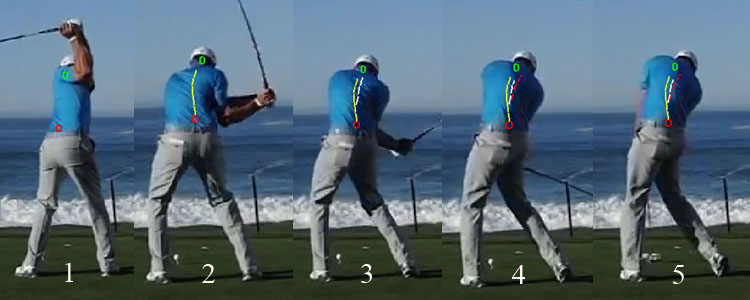Post by imperfectgolfer on Jan 2, 2023 13:02:07 GMT -5
The term "right lateral bend" is used by many golf instructors, but I suspect that they use the term differently.
Here is a back-view series of capture images of Dustin Johnson's driver golf swing action from P4 => P7.

I was recently having a personal e-mail communication with Milo Lines and he stated that he teaches golfers to acquire right lateral bend at the very start of the transition to the downswing while I believe that it should only happen later after P5. After a number of back-and-forth e-mail messages I came to realise that I use the term "right lateral bend" to describe a very different biomechanical motion than the one Milo describes.
So, I will now clearly describe what I mean when I use the term "right lateral bend".
Here is a back-view series of capture images of Dustin Johnson's driver golf swing action from P4 => P7.

Image 1 is at P4, image 2 is at P5, image 3 is at P5.5, image 4 is at P6.4 and image 5 is at P7.
I have drawn a red circular marker over the lower end of his lumbar spine at his P4 position, and a green circular marker at a point where I suspect that his first thoracic vertebra is likely located. I cannot obviously see his upper thoracic spine because it is obscured by his right scapula/upper chest region due to the fact that he has rotated his upper torso ~110 degrees by P4. One can see that his lumbar spine is tilted to the right, but one cannot clearly see whether his thoracic spine is vertical or tilted leftwards. If one uses one's "imagination" to draw a line between his T1 vertebra and his L5 vertebra, I don't think that one would say that he has "right lateral bend" at his P4 position.
Image 2 is at his P5 position. I have drawn a yellow line along the length of his spine and one can clearly see that his spine has a rightwards concave curvature. Milo Lines labels this rightwards spinal curvature as being evidence of a "right lateral bend" scenario. I disagree - because I think that it is mainly due to the fact that he has rotated his pelvis, and therefore lumbar spine, clockwise by ~50+ degrees between P4 => P5 (which changes the rotational alignment between his pelvis and upper torso) and I believe that there has been no active rightwards lateral bending motion of his thoracic spine that is designed to cause the shoulders to rotate in a more ferris-wheel manner during the mid-later downswing.
Image 3 is at his P5.5 position. I have drawn a white curved line to show that his thoracic spine is now bending more laterally rightwards.
Image 4 is his P6.4 position. I have drawn a red curved line to show that his thoracic spine is bending even more laterally rightwards.
In other words, while his upper torso is rotating counterclockwise between P5 => P7 he is actively bending his thoracic spine in a "right lateral bend" direction that allows his shoulders to rotate in a more "ferris-wheel" manner (and not a "merry-go-round" manner) during his mid-late downswing action. That's what I mean by the term "right lateral bend" and I do not use the term "right lateral bend" to describe the rightwards concave curvature of the spine seen between P4 => P5 that is causally due to an active pelvic rotary motion that changes the lumbar spine's alignment relative to the thoracic spine's alignment.
Jeff.
